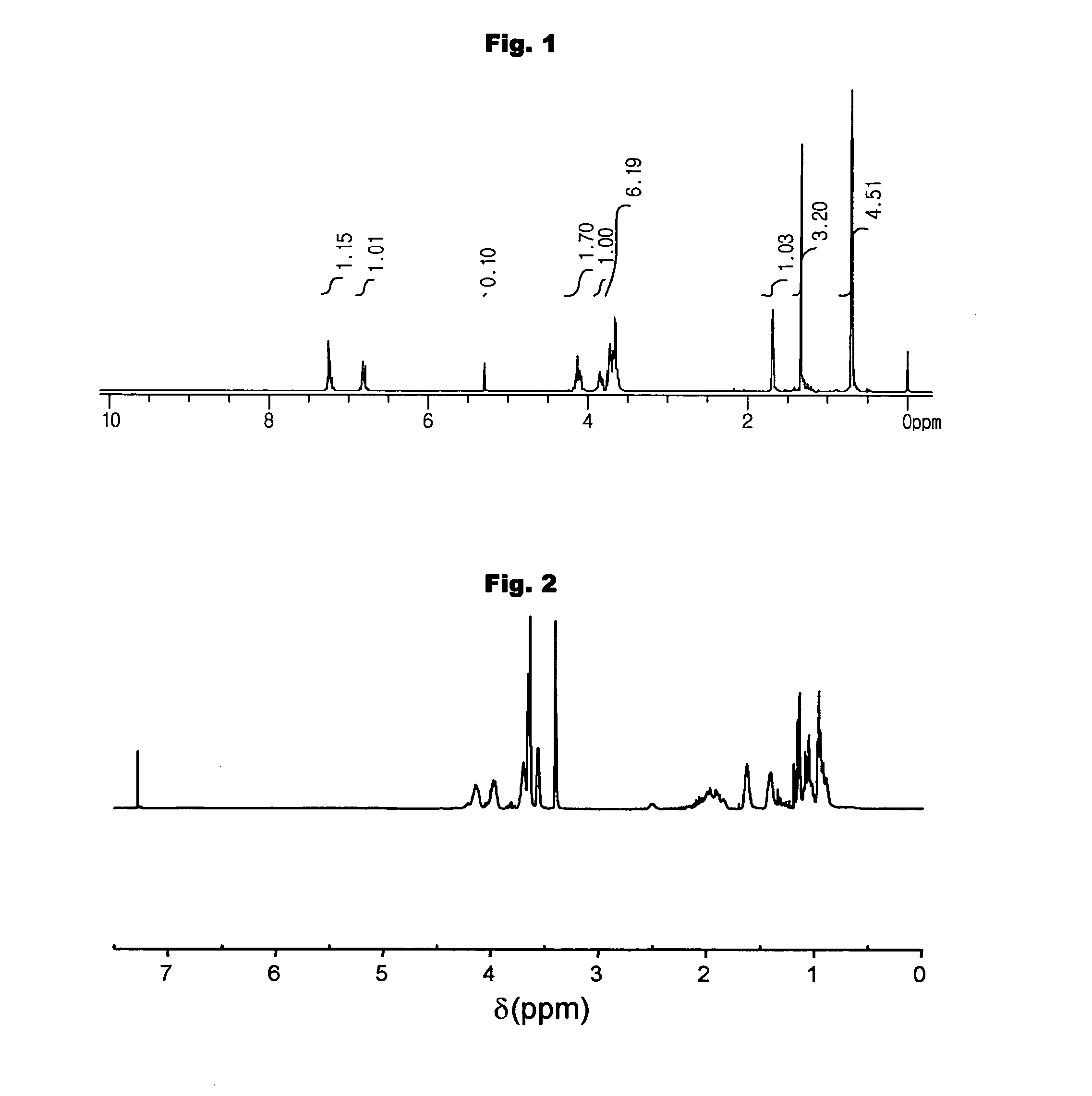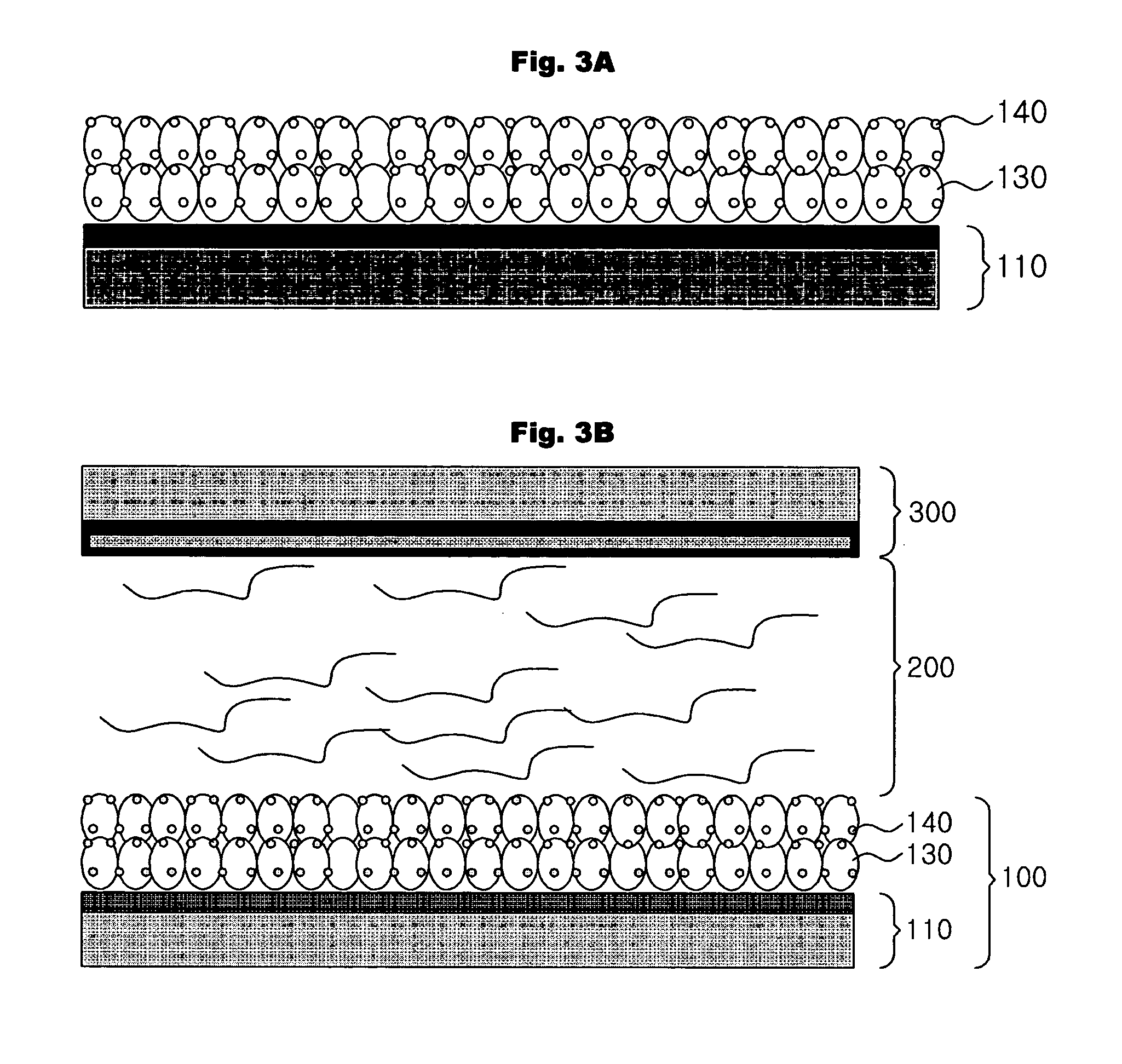Metal oxide paste composition and method of manufacturing semiconductor electrode using the same
a technology of metal oxide paste and composition, which is applied in the manufacture of non-metal conductors, final products, conductors, etc., can solve the problems of large-scale, expensive systems and equipment to manufacture silicon solar cells, and the inability to achieve the photoelectric efficiency of a solar cell manufactured using the same, etc., to achieve the effect of improving the dispersibility
- Summary
- Abstract
- Description
- Claims
- Application Information
AI Technical Summary
Benefits of technology
Problems solved by technology
Method used
Image
Examples
example 1
Preparation of Metal Oxide Paste Composition
[0065] As metal oxide in this Example, 16 g of commercially available nanocrystalline titanium dioxide (nc-TiO2) (Aeroxide® P25, Degussa; 80% anatase and 20% rutile) was used. In order to remove water and volatile organics from the titanium dioxide powder before use, the titanium dioxide was dried in a vacuum at 130° C. for 24 hours. As a solvent, 28.48 g of a 1.8:1 wt / wt mixture of α-terpineol (Kanto Chemical Co., Japan) and butyl carbitol acetate (Kanto Chemical Co., Japan) was used. As an organic binder, 2.4 g ethyl cellulose (ETHOCEL”, standard 45, Dow Chemical Corp, USA) was used. Ethyl cellulose and the mixture of α-terpineol and butyl carbitol acetate were mixed with each other at a weight ratio of 3:5 in a silicone oil bath at 50° C. so as to prepare an ethyl cellulose binder solution. To the prepared ethyl cellulose binder solution, the TiO2 nanoparticles were added, and the dispersant of Formula 9 as synthesized in the above syn...
examples 2 to 4
[0066] Metal oxide paste compositions were prepared in the same manner and using the same amounts and proportions as described in Example 1, except that compounds of Formula 7 (for Example 2), Formula 8 (for Example 3), and Formula 9 (for Example 4) were used as dispersants.
example 5
[0073] On a glass substrate, fluorine-doped tin oxide (FTO) was applied through sputtering to form a transparent electrode. Then, the nc-TiO2 particle paste prepared in Example 1 was applied on the transparent electrode through a screen printing technique and dried at 70° C. for 30 minutes. After completion of the drying, the resulting substrate was placed in an electric furnace, in which it was heated at a rate of 3° C. / min in air and maintained at 450° C. for 30 minutes and then cooled at a rate of 3° C. / min, thus forming a porous TiO2 film.
[0074] Next, the glass substrate having the metal oxide layer formed thereon was immersed in a solution of 0.3 mM cis-bis(isothiocyanate)bis(2,2′-bipyridyl-4,4′-dicarboxylato)-ruthenium (“N3 dye”) in ethanol (3 mM) for 16 hours and then dried, so that the dye was adsorbed on the surface of the TiO2 layer, thus manufacturing a semiconductor electrode.
[0075] Meanwhile, platinum was coated on a conductive transparent glass substrate coated with ...
PUM
| Property | Measurement | Unit |
|---|---|---|
| Temperature | aaaaa | aaaaa |
| Temperature | aaaaa | aaaaa |
| Current | aaaaa | aaaaa |
Abstract
Description
Claims
Application Information
 Login to View More
Login to View More - R&D
- Intellectual Property
- Life Sciences
- Materials
- Tech Scout
- Unparalleled Data Quality
- Higher Quality Content
- 60% Fewer Hallucinations
Browse by: Latest US Patents, China's latest patents, Technical Efficacy Thesaurus, Application Domain, Technology Topic, Popular Technical Reports.
© 2025 PatSnap. All rights reserved.Legal|Privacy policy|Modern Slavery Act Transparency Statement|Sitemap|About US| Contact US: help@patsnap.com



